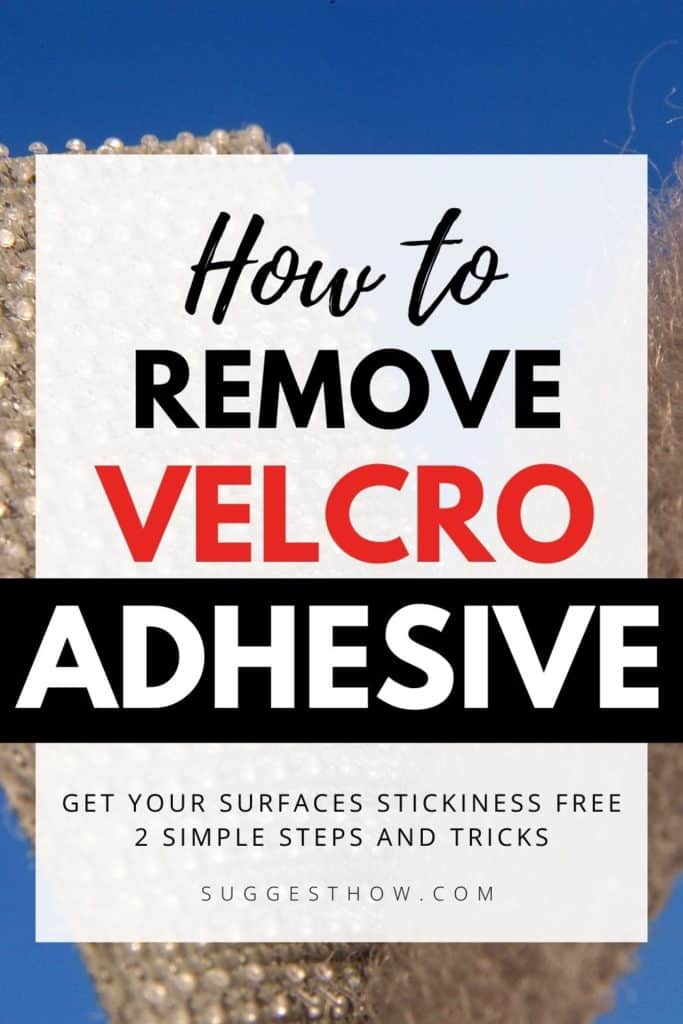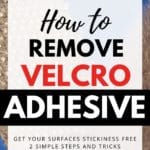This post has affiliate/referral links. Learn more.
The velcro is a hook and loop fastener that is commonly used across several products from wristwatches and shoes to pockets, clothes, and much more.
It’s handy, easy, and effective. Velcro used in wall hangings and carpets is also very strong and long-lasting.
However, the effectiveness of the velcro adhesive that makes it a popular product acts against you when you want to remove the velcro from said material.
It makes removing velcro from a surface quite the task. Also, the residue of the glue left behind forms patches or stains and gets very hard to remove over time.
Therefore when you are removing the velcro from any surface, you must also be equipped with knowledge on how to remove velcro adhesive to really complete the job of removing the velcro.

How to Remove Velcro Adhesive
Removing velcro adhesive largely involves just two main steps — one is dissolving the glue so that it gets softer.
The next step is to scrape it away.
However, depending on the surface and depending on your own convenience, there are several options and tips on how to execute these steps. These are as follows:
Step 1: Dissolving the Velcro Glue
When you dissolve the glue, it gets softer, which makes it easier for you to remove the velcro adhesive. There are several products you can use to soften the glue, most of which might be available in your kitchen.
1. Hot water
If you have removed velcro from a shirt or another piece of cloth, or any other item that is safe to be soaked in water, then you can try this approach.
Fill up a bucket of hot water and add a few drops of dishwashing liquid to it. Soak the item in this water solution and make sure that the adhesive portion is well immersed.
After a few minutes, remove it from the bucket and try to scrape the glue away, as it would have softened up.
2. Vinegar
Add a few drops of white vinegar to a cup of lukewarm water. Dip a clean cloth completely in this diluted vinegar solution and place the cloth on the area where the velcro adhesive is.
Leave it on for about twenty minutes and check whether the glue residue has softened up.
If you are removing velcro adhesive from the sides of the wall or floor, you would need to test the solution on the surface first to see if it sustains any damage.
Once you are sure it works, you may go ahead and add a few drops directly on the floor and leave it on to soak.
Once the glue softens, you can scrape it away.
3. Coconut Oil or Olive Oil
If you are trying to remove residue from glass or plastic, you could use an oil-based remover.
This will be more ideal for any acrylic/glass or plastic surface.
For tough glue stains, leave the oil on overnight. The next day, you can scrape away at the softened glue.
4. Rubbing alcohol
In order to remove velcro adhesive from glass or plastic, as an alternative to oil, you could use rubbing alcohol.
If oil seems to be ineffective for some reason or does damage to a specific item, then you may dip a cloth in a solution of rubbing alcohol or vodka and then wipe the residue with the cloth.
This will also work well on wooden surfaces.
5. Baking soda + oil paste
Experts recommend any citrus-based remover to get rid of velcro adhesive.
If you are wondering how to remove velcro adhesive the easy way, then you can use baking soda and lemon to make your own homemade adhesive remover.
Mix about two tablespoons of baking soda with half a tablespoon of water and make a paste. To this paste, add a couple of drops of lemon essential oil or some lemon juice.
Lemon or any citrus-based solution is said to naturally dissolve any adhesive. If you do not have lemon oil, you could just mix equal parts of baking soda and any cooking oil to make a thick paste-like liquid.
Apply this DIY adhesive remover to the area where there is leftover velcro adhesive, leave it on to soak for a few minutes.
Once the glue softens up, wipe it with a piece of cloth or tissue.
You can also store this remover in a jar as an all-purpose kitchen countertop cleaner for any occasion.
6. Commercial Adhesive Removers
If none of the above DIY methods work for you, or you want a solution tailored for the issue, you may opt for store-bought adhesive removers.
These are available online. Some effective ones include Goo Gone, WD-40 and Smith & Nephew UNI-SOLVE Adhesive Remover.
Note that you should test these solutions on whichever surface you use it on, to confirm that it does not cause any damage.
These are a few quick and effective options if you are wondering how to remove velcro adhesive with products available at home or for purchase.
Step 2: Scraping the Velcro Adhesive
Scraping away at softened glue is the easier part. The tougher part is to use the right product to dissolve the velcro adhesive for it to soften up.
Once that is done you may use one of the following tools to scrape away at the adhesive.
- A putty knife
- An old credit card or gift card (plastic)
- Your fingernails, to some extent.
- An old toothbrush
You may also use a hairdryer to direct heat at the residue so that the glue softens up.
Then you can use a knife or blade to scrape away at the residue.
If you are worried about damaging the surface, gently pull at the residue and once you have freed up the glue, wipe the surface with a piece of rug.
When you remove velcro steps sewn to a garment, you will have to free the stitches holding the strip to the cloth with a pair of scissors and cut it out of the cloth.
Try these easy methods on how to remove velcro adhesive yourself. Good luck with all the action, and do not forget to be patient!
What dissolves sticky adhesive?
You can try any citric-based solution to remove any adhesive.
Especially for velcro adhesive, you can use diluted white vinegar.
To remove adhesive from wooden surfaces you can use rubbing alcohol or vodka, and olive oil for glass surfaces.
What is a natural adhesive remover?
Mix equal parts of baking soda and cooking oil to make your own homemade adhesive remover.
Alternatively, you can mix about two tablespoons of baking soda with half a tablespoon of water and make a paste.
To this paste, add a couple of drops of lemon essential oil. Lemon or any citrus-based solution is said to naturally dissolve any adhesive.
Takeaway
If you are wondering how to remove velcro adhesive the easy way, you could simply choose to dissolve the residual glue using natural solvents such as diluted white vinegar, hot water, rubbing alcohol, vodka, or a simple homemade paste made with equal parts of baking soda and cooking oil.
Once the glue has softened up, scrape it away using a blade, putty knife or any other safe scraper.
How to Clean Velcro – 6 Methods for Straps, Hooks, Rollers and More
How to Remove Carpet Glue from Tile – 3 Simple Ways






I have just spent e days removing Velcro adhesive from UPVC window frames and the best results were obtained using surgical spirit and a plastic card. Hard work but does work oh yes and a lot of elbow grease !! Hope this helps someone. R. C.